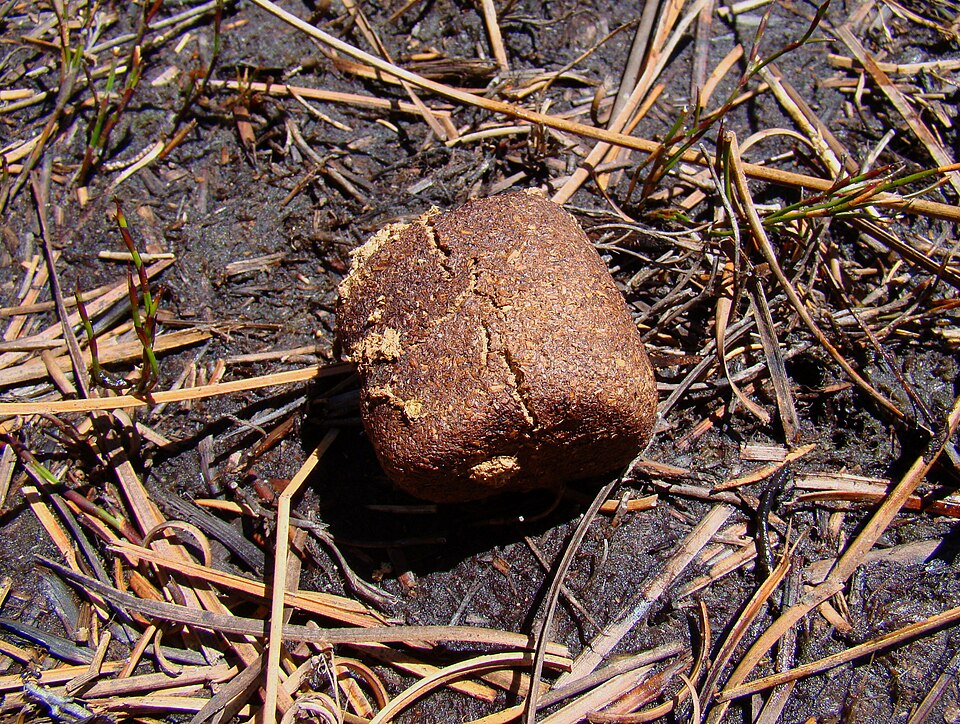
How is wombat poo cube shaped? They have a very elastic intestinal tract, which shapes their poo into 2 cm cubes.
Wombats are four-legged marsupials that are native to Australia. They are low to the ground and weigh about 35 kg, giving them a low center of gravity. A lot of different types of wombats used to exist, but they have all gone extinct. The largest of these weighed about 360 kg and would have been about the size of a bear. Wombats dig tunnels and spend most of the day underground. They come up to feed in the evening, at night, and at dawn. They dig their tunnels with their strong front legs, claws, and their front teeth. Just like a beaver, their front teeth never stop growing, so they have no problem wearing them down. They don’t need to eat much because they have a very slow metabolism. This means they can survive in areas without much food or water, but it also means that they can’t move very quickly. Wombats can defend themselves against predators with their sharp claws, but their best defense is their rump. They have a thick layer of cartilage and hide in their rump, which is almost impossible for a predator to bite through. If they can get into one of their tunnels, there is no way a predator can get a purchase to pull them out.
Wombats are famous for being the only animals that have square poo. For every other animal on Earth, it is round. This makes sense because the intestine is round, and the anus is round. Round is biologically simple. Square is more complex. Why wombats have square poo and how they do it are two different questions, and the why is easier than the how. Wombats most likely have evolved square poo to stop it rolling away. They use their poo to mark where their burrows are and to attract a mate. Wombats don’t have very good eyesight, but they do have a very good sense of smell. Studies have shown that their sense of smell is even better than that of a dog. This means they can’t see where their burrow is, but they can smell it. They pile their poo in front of the burrow. Round poo would roll away, so they have evolved square poo, which stays where they put it. They also know the smell of their own poo, and they can use it to mark their territory. If they smell another wombat’s poo, they know they are in the wrong place and they leave as quickly as they can. The second reason is to attract a mate. The wombats deposit about 100 square poos every nigh,t and they pile their poo up in stacks. The bigger the stack, the more likely they are to attract a mate. That would give wombats that had square poo a biological advantage because it is stackable.
How they make square poo seems a little more difficult to explain. Researchers in Australia dissected several wombats that had been killed by cars. (Incidentally, wombats are the second largest cause of traffic accidents, mostly when drivers swerve to avoid them and hit a tree or another car. The leading animal cause of traffic accidents in Australia is kangaroos.) These researchers found several differences in a wombat’s intestine from those of other animals. The first is the amount of water the wombat can remove from its food. Our food goes through our digestive system in one or two days, but it takes over a week for food to get through the wombat’s digestion. That gives it a lot more time to extract water and nutrients. All of this happens in the first 92% of the intestine. It is the last 8% where the poo is made into cubes. The last part of the wombat’s intestine has two very elastic grooves in it. There are also layers of muscle and tissue that are different in thickness and in stiffness. As the very dry poo moves through this part of the intestine, the muscles contract and the stiff areas of the intestine flatten the sides, while the elastic parts shape the corners. It doesn’t happen right away, but the poo takes a long time to move through the intestine, maybe up to a day for just this part, and the repeated contractions of the muscles slowly shape the poo into a cube. When it pops out, it is the perfect shape to be stacked. A very impressive skill. And this is what I learned today.
Get all 6 volumes of 125 Questions You Never Knew You Had (375 questions) for kindle: https://mybook.to/125questions6books
Sources
https://www.bbc.com/news/world-australia-46258616
https://www.science.org/content/article/how-do-wombats-poop-cubes-scientists-get-bottom-mystery
https://edition.cnn.com/2021/01/29/australia/wombat-poop-cubes-intl-scli-scn
https://en.wikipedia.org/wiki/Wombat
Image By Bjørn Christian Tørrissen – Own work by uploader, http://bjornfree.com/galleries.html, CC BY-SA 3.0, https://commons.wikimedia.org/w/index.php?curid=6496588
